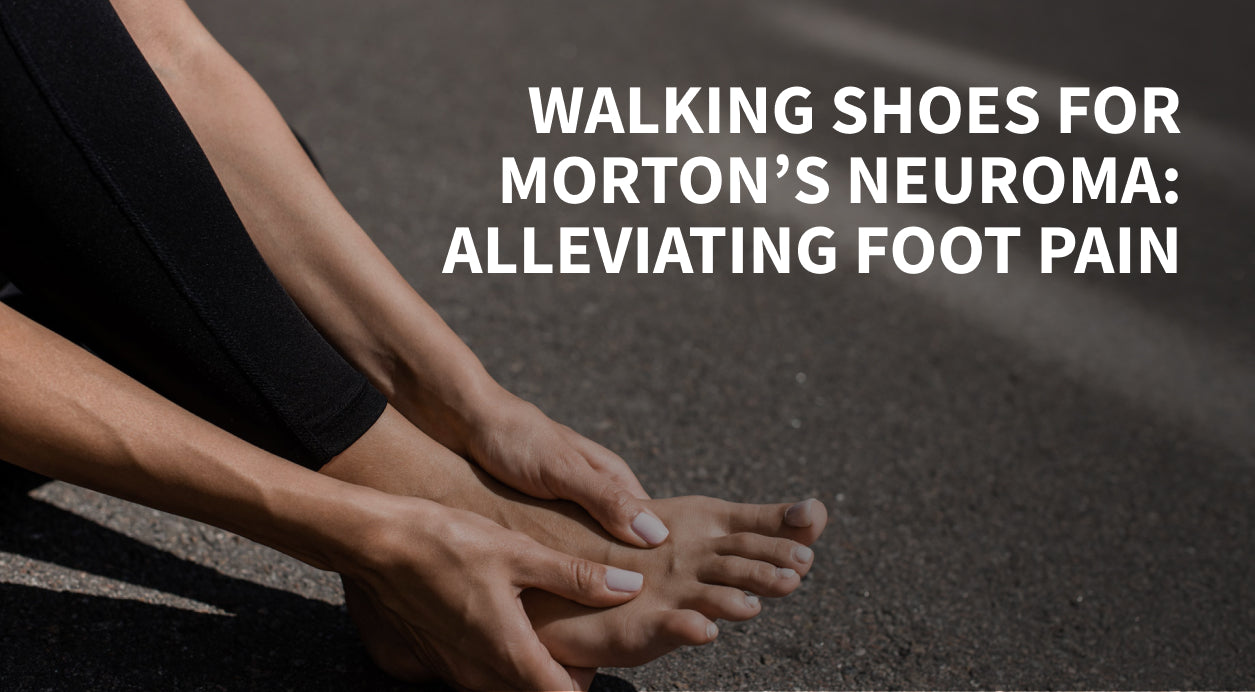Walking Shoes for Morton's Neuroma: Alleviating Foot Pain
Are you tired of dealing with the excruciating foot pain caused by Morton's neuroma? Lucky Feet Shoes is here to help. We understand the struggle you face when trying to find relief, especially while walking.
We'll guide you through the process of finding the perfect walking shoes to alleviate your foot pain. Discover the features you should look for and learn how to properly fit your shoes to accommodate your Morton's neuroma.
Say goodbye to foot pain and reclaim your mobility!
Schedule yourfree foot analysis
Definition of Morton's Neuroma
If you're experiencing foot pain on the ball of your foot, beath your toes, and suspect you may have Morton's neuroma, it's important to understand what it is and what symptoms to look out for.
Morton's neuroma (or Morton Neuroma) is a condition that occurs when a nerve in the foot becomes compressed or irritated and thickened, usually between the third and fourth toes. This can cause pain, numbness, tingling, and a feeling of walking on a pebble or small object.
While called "neuroma," it's not an actual tumor but simply a mass of tissue that has formed in the forefoot and is blocking proper circulation and nerve function.
Causes
The main cause of this condition is excessive pressure on the nerve in the ball of your foot.
This pressure can be caused by various factors, such as wearing tight or narrow footwear that squeezes your toes together. High heels can also contribute to the development of Morton's neuroma as they put additional pressure on the forefoot.
Morton's is also common in people who routinely perform activities that involve repetitive movements or impact on the feet, such as running or jumping, which can increase the risk of developing this condition.

Symptoms
The most common symptom is a sharp, burning pain in the ball of the foot and toes, with some occasional tingling or numbness in the toes. The pain typically worsens with activity and improves with rest.
The other symptoms associated with Morton's Neuroma are:
- A feeling of a lump or thickened area in the forefoot
- Pain that worsens with walking or wearing tight shoes
- Pain relief when removing shoes or massaging the foot
- The sensation of walking on a pebble or having a wrinkle in the sock
- Pain that radiates to the nearby toes
- Swelling or inflammation in that area.
- Difficulty in bearing weight on the affected foot.
Top Treatments for Morton's Neuroma
One effective treatment option for Mortons neuroma is to invest in proper walking shoes that provide adequate support and cushioning. When it comes to finding the right pair of shoes, comfortable shoes are key.
Look for footwear with a cushioned sole that can help alleviate the pain caused by this painful condition.
Insoles can also provide additional support and cushioning for Mortons neuroma, so consider purchasing shoes with removable insoles that you can replace with custom foot orthoses if needed, with another option being metatarsal pads to relieve pressure on the affected area. Metatarsal pads are essentially cushions that can either be slip-on or simply placed on the bottom of the forefoot, where support is needed while wearing shoes. There are both over-the-counter metatarsal pads and custom-made pads that can be fitted to your foot sizes and needs.
If you do opt for metatarsal pads, make sure to try out any pair of walking footwear with them to see if they fit properly with your choice.
Remember to try on several pairs of shoes to find the perfect fit and avoid any discomfort or rubbing. Investing in a pair of shoes that prioritize comfort and support can make a significant difference in managing the symptoms of Morton's neuroma.
If therapy by wearing more appropriate shoes or pads has not been effective in relieving the symptoms of Morton's neuroma, your doctor may recommend other, more invasive options. One is cortisone injections, where steroids are injected into the painful area to provide relief.
The second is decompression surgery, where surgeons can alleviate pressure on the affected nerve by cutting nearby structures, such as ligaments. In more severe cases, surgical removal of the nerve growth may be necessary if other treatments have failed to provide pain relief. It is important to note that while surgery is generally successful, it can lead to permanent numbness in the toes.
Types of Shoes to Avoid
When it comes to finding the right shoes for Morton's neuroma, there are certain types you should avoid, with the main rule being: nothing that's too tight or puts too much strain on your toes, the ball of your foot or forefoot. It's tempting to ignore neuroma pain and put on your cute shoes for one night of walking on the town or stylish shoes at work, but any minute with ill-fitting shoes on a regular basis just makes the pain worse and makes it harder to get treated through non-invasive methods.
Heeled Shoes
Avoid high-heeled shoes if you want to alleviate foot pain caused by Morton's neuroma. High heels can exacerbate the symptoms and make walking uncomfortable. Some of the worst offenders are heels like Stilettos, with their ultra-high heels that put excessive pressure on the ball of your foot, increasing the risk of pain and discomfort and can lead to several foot conditions.
Others with problematic heels are wedges, which might be more stable but can still aggravate foot pain, and platforms, which are too elevated for people with Morton's or other foot conditions, plantar fasciitis, bone spurs, bunions, or just about any orthopedic problem.
To alleviate your foot pain and promote healing, opt for supportive walking shoes with a lower heel or no heel at all. Prioritize comfort and stability to keep your feet happy and pain-free.

Tight or Narrow Fitting Shoes
It's important to find walking shoes that provide ample room for your feet to breathe and move comfortably. If you have flat feet or experience foot pain, steer clear of narrow-fitting shoes that can exacerbate the discomfort in the long run and impede healing. Narrow-fitting shoes can put pressure on the affected area and worsen the symptoms of Morton's neuroma.
Tight-fitting shoes are another danger to avoid. Although this might seem like the same thing as narrow-fitting shoes, it is not. Narrow shoes don't always feel tight at first and feel just fine, whereas many people buy tight-fitting shoes with disregard for their foot health. Tight shoes compress the bones in your feet, leading to increased pain and discomfort.
Dress Shoes or Boots
Steer clear of dress shoes that can exacerbate foot pain caused by Mortons neuroma by opting for styles that provide ample room and support. It's common for dress shoes to be pointy-toed or squeeze your toes together, putting pressure on the affected area and causing discomfort. When dealing with Mortons neuroma, always go for wide-fitting shoes.
Avoid too flat shoes with no arch support, as they provide little to no support for your arches, which can exacerbate any pain caused by Morton's or other painful foot conditions.
Furthermore, it's important to avoid boots as they often lack the flexibility and proper cushioning needed for walking comfort. Many lack the cushioning needed for walking, and they're not exactly the best (or most fashionable) footwear for this activity anyway.
Athletic Shoes Not Designed for Walking
It might be surprising to learn that some athletic shoes, while good for other common foot conditions and activities, might not work for alleviating Morton Neuromas, so be cautious of athletic shoes that aren't specifically designed for walking.
While running shoes and fitness shoes may seem like good options, they're usually designed with different purposes in mind. Running shoes, for example, are designed for forward motion and shock absorption, which may not provide the necessary support and stability for walking with Morton's Neuroma.
Similarly, fitness shoes are typically designed for activities like aerobics or cross-training and may not offer the required cushioning and arch support for walking.
The golden rule to alleviate foot pain caused by Mortons Neuroma is to opt for walking shoes that are specifically designed to provide the necessary support and comfort for this condition.
Features of Good Neuroma Shoes for Walking Sufferers
When looking for a good walking shoe for Morton's Neuroma, there are a few key features to consider.
Cushioned Sole and Insoles
Walking shoes with a cushioned sole and cushioned insole are essential for providing comfort and support for Morton's Neuroma sufferers due to the specific needs of this condition.
The cushioned sole of walking shoes helps to absorb shock and reduce pressure on the affected area, providing relief and preventing further aggravation. The cushioning also helps to distribute weight evenly across the foot, reducing the strain on the affected nerves. This extra support and cushioning in the sole can greatly alleviate pain and discomfort, allowing Morton's Neuroma sufferers to walk more comfortably and with less risk of exacerbating their condition.
Also, look for extra padding around the toe area, which helps prevent irritation and rubbing, along with the option for shoe inserts. This feature allows you to customize the fit and accommodate orthotic inserts for additional support.
Ample Room in Toe Box Area
To ensure maximum comfort and support for Morton Neuroma sufferers, it's essential to find walking shoes that provide ample room in the toe box area. When dealing with this condition, the nerves between the toes become inflamed, causing pain and discomfort. Therefore, having enough space in the toe box area is crucial to prevent any additional pressure on the affected area.
Look for supportive shoes that have a deep and wide toe box, allowing your toes to move freely without being cramped or squeezed together. These wider shoes will help alleviate the pain and provide much-needed relief. Many times, bespoke or custom-made shoes might be just too snug for many people who can suffer from Morton's, so it's best to avoid them if you're prone to getting measured for a fitted shoe.
Consider choosing shoes with adjustable features, such as laces or Velcro straps, so you can customize the fit to accommodate your specific needs.

Space for Metatarsal Pads or Inlays
If you suffer and are looking for relief from Mortons Neuroma, you'll hear a lot about metatarsal pads, as we established earlier. These foot pads go on the bottom of the forefoot to alleviate ball of foot pain and provide additional support.
These specialized inserts are designed to cushion and support the metatarsal bones, relieving pressure on the affected area and reducing pain. Make sure both your right and left foot need them; otherwise, only focus on the afflicted foot or get different, custom-made metatarsal pads for each one.
Arch Support
Another key feature to look for in walking shoes for Morton Neuroma is proper arch support. Shoes with proper arch support help distribute weight evenly across the entire foot, correcting inadequate gait and abnormal posture, reducing forefoot pressure on the neuroma, and helping with this potentially debilitating condition.
Arch support also helps to stabilize and improve overall foot alignment, reducing the risk of further aggravating the condition.
Supportive and Stable Construction
When looking for walking shoes to alleviate and prevent neuroma pain, it's important to prioritize supportive and stable construction.
Your feet need the right kind of support to help relieve the pressure on the affected nerve. Look for shoes with a firm and cushioned midsole that provides stability and absorbs shock. While a soft sole can be comfortable, it might not be supportive. The key to fighting neuroma pain with comfy shoes is to find a balance between cushioning and support.
A structured heel counter or deep heel cup and a secure lace-up or Velcro closure on a neutral shoe will also ensure a stable fit and prevent your foot from sliding forward, further aggravating the condition. Again, it has to be a wide-fitting shoe without being too loose and unsupportive.
When trying on shoes, also pay close attention to the fit of your left foot, as this is often the foot that experiences the most pain in people who are right-handed or right-footed, although this can vary.
Nonetheless, remember that finding the correct shoes for walking can make a significant difference in alleviating your foot pain and promoting healing.
Realize the Importance of Good Walking Shoes. Lucky Feet Shoes is Here to Help
Don't let Morton's neuroma keep you from enjoying the freedom of walking. By choosing the right pair of walking shoes that provide ample support, cushioning, and room for your sensitive feet, you can find relief from foot pain.
With the help of Lucky Feet Shoes' guide, you can reclaim your mobility and get back to doing what you love. Say goodbye to discomfort and hello to comfortable walks!

Jerick Sobie
Since 2005, I have been a dedicated small business owner specializing in footwear retail. With over 20 years of experience, my business partner and I have helped customers find the perfect shoes that combine style, comfort, and quality. Our expertise extends beyond local sourcing—we have traveled internationally to discover high-quality footwear that meets our customers’ needs. In addition to running my business, I have participated in numerous health fairs and educational seminars, sharing my knowledge on proper footwear and foot health. Committed to providing exceptional service, We carefully curate our selections to ensure the best fit and support for every customer.
















